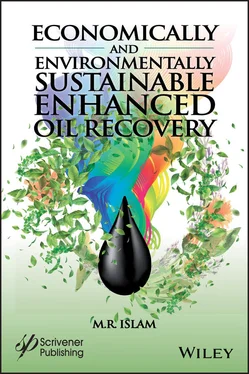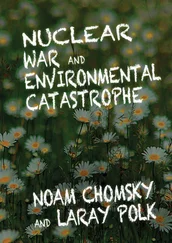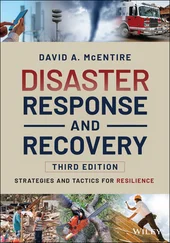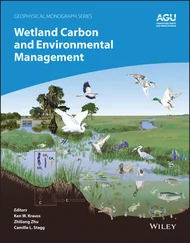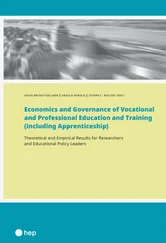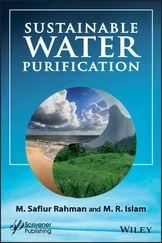Picture 2.2 shows how these artificial proppants with cylindrical shape are claimed to create better fractures. Figure 2.7 demonstrates that sands have the worst fracture efficiency, while the rod-shaped proppants have the highest efficiency. In this process, material cost of fracturing has skyrocketed and accounts for bulk of the fracturing scheme. The same can be said about fracturing fluid. It turns out water is not conducive to creating fractures in shale formations. In 1976, the US government started the Eastern Gas Shales Project, a set of dozens of public–private hydraulic fracturing pilot demonstration projects. During the same period, the Gas Research Institute, a gas industry research consortium, received approval for research and funding from the Federal Energy Regulatory Commission. That was the beginning of fracturing shale formations that gave boost in gas production throughout late 1970s and 1980s. In 1997, based on earlier techniques used by Union Pacific Resources, now part of Anadarko Petroleum Corporation, Mitchell Energy, now part of Devon Energy, developed the hydraulic fracturing technique known as “slickwater fracturing” that involves adding chemicals to water thereby allowing increase to the fluid flow, which made the shale gas extraction economical. These chemicals are both expensive and toxic to the environment.

Picture 2.2Typical proppants, used during fracturing.
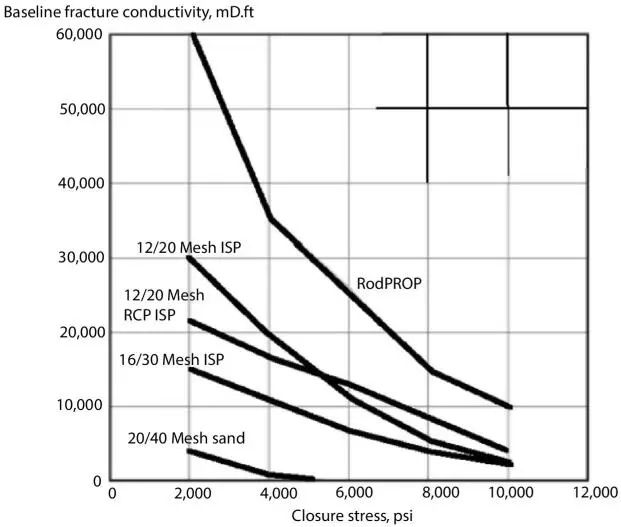
Figure 2.7Effect of proppant geometry on fracturing efficiency.
The fracturing fluid varies in composition depending on the type of fracturing used, the conditions of the specific well being fractured, and the water characteristics. A typical fracture treatment uses between 3 and 12 additive chemicals. A typical fracturing operation involves the following chemicals:
Acids: hydrochloric acid (for carbonate cements) or acetic acid (for silicate cement) is used in the prefracturing stage for cleaning the perforations and initiating fissure in the near-wellbore rock.
Sodium chloride: delays breakdown of the gel polymer chains.
Polyacrylamide and other friction reducers: reduces turbulence (lower Reynold’s number), while increasing proppant transport in the tubing or drill pipe.
Ethylene glycol: prevents formation of scale deposits in the pipe.
Borate salts: thermal stabilizers that maintain fluid viscosity under high temperature conditions.
Sodium and potassium carbonates: used for maintaining effectiveness of cross-linkers that stabilize the polymer.
Glutaraldehyde: used as disinfectant of the water to prevent bacterial growth and subsequent biodegradation of the fluid.
Guar gum and other water-soluble gelling agents: increases viscosity of the fracturing fluid to deliver more efficiently the proppant into the formation.
Citric acid: used for corrosion prevention as it is a milder form for corrosion inhibitors.
Isopropanol: increases the viscosity of the fracturing fluid.
The most common chemical used for hydraulic fracturing in the United States in 2005–2009 was methanol, while some other most widely used chemicals were isopropyl alcohol, 2-butoxyethanol, and ethylene glycol. New generation of chemicals include: Conventional linear gels (carboxymethyl cellulose, hydroxyethyl cellulose, carboxymethyl hydroxyethyl cellulose, hydroxypropyl cellulose, methyl hydroxyl ethyl cellulose), guar or its derivatives (hydroxypropyl guar, carboxymethyl hydroxypropyl guar), etc. These gels have higher viscosity at pH of 9 onwards and are used to carry proppants. After the fracturing job the pH is reduced to 3–4 so that the cross-links are broken and the gel is less viscous and can be pumped out. Organometallic cross-linked fluid zirconium, chromium, antimony, titanium salts are known to cross-link the guar-based gels. The cross-linking mechanism is not reversible. Aluminum phosphate–ester oil gels. Aluminum phosphate and ester oils are slurried to form a cross-linked gel. These are one of the first known gelling systems.
As stated earlier, hydraulic fracturing has been used for decades to stimulate increased production from existing oil or gas wells. This technique, along with other well stimulation techniques, has been regulated to varying degrees through state oil and gas codes. The detail and scope of applicable regulations vary across the states, and some states have regulated “well stimulation” broadly without addressing hydraulic “fracturing” explicitly. State regulators have noted that hydraulic fracturing operations are regulated through provisions that address various production activities, including requirements regarding well construction (e.g., casing and cementing), well stimulation (e.g., hydraulic fracturing), and well operation (e.g., pressure testing and blowout prevention). Nonetheless, state groundwater protection officials also have reported that development of shale gas and tight oil using high-volume hydraulic fracturing, in combination with directional drilling, has posed new challenges for the management and protection of water resources. Consequently, many of the major producing states have revised or are in the process of revising their oil and gas laws and regulations to respond to these advances in oil and natural gas production technologies and related changes in the industry.
The debate over the groundwater contamination risks associated with hydraulic fracturing operations has been fueled, in part, by the lack of scientific studies to assess more thoroughly the current practices and related complaints and uncertainties. To help address this issue, Congress has directed the EPA to conduct a study on the relationship between hydraulic fracturing and drinking water. The “hydraulic fracturing” debate also has been complicated by terminology. Many who express concern over the potential environmental impacts associated with hydraulic fracturing do not differentiate the well stimulation process of “fracking” from the full range of activities associated with unconventional oil and gas exploration and production.
In summary, the petroleum era has been about profiting from processing, rather than getting value from the energy resource. Even for the chemicals used to augment production have become entirely artificial, leading to sustainability concerns both in terms of environment and economics.
Ever since the oil crisis of 1973 that was triggered by the boycott of oil import by some Middle Eastern countries, the American general public has been continuously primed to face energy crisis that is perceived to be forthcoming. Since the demand for oil is unlikely to decline it inevitably means that the price will increase, probably quite dramatically. This crisis attributed to peak oil theory is proposed to be remedied with 1) austerity measures in order to decrease dependence on energy, possibly decreasing per capita energy consumption, and 2) alternatives to fossil fuel (Speight and Islam, 2016). None of these measures seem appealing because any austerity measure can induce imbalance in the economic system that is dependent on the spending habit of the population and any alternative energy source may prove to be more expensive than fossil fuel. These concerns create panic, which is beneficial to certain energy industries, including bio-fuel, nuclear, wind, and others. Add to this problem is the recent hysteria created based on the premise that oil consumption is the reason behind global warming. This in itself has created opportunities with many sectors engaged in carbon sequestration.
Читать дальше
